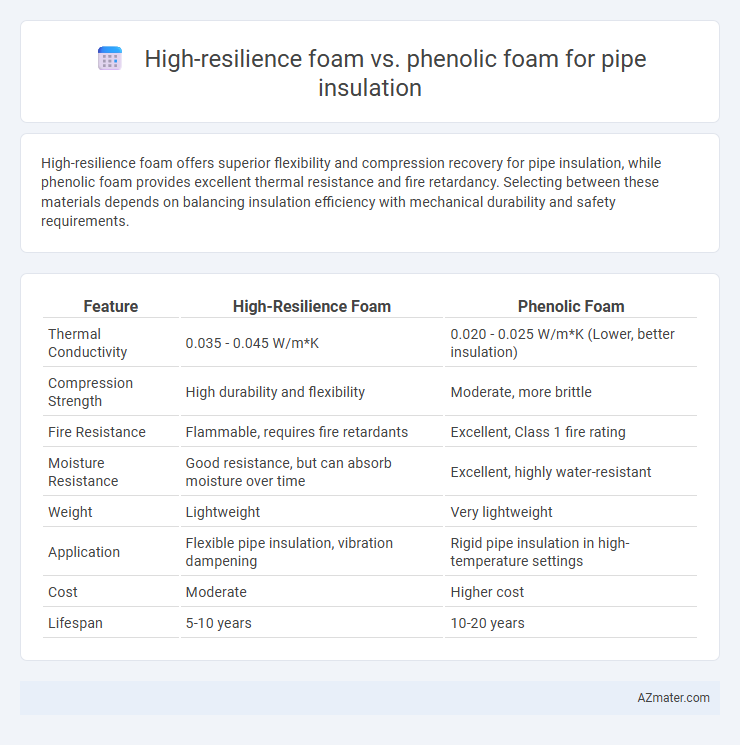High-resilience foam offers superior flexibility and compression recovery for pipe insulation, while phenolic foam provides excellent thermal resistance and fire retardancy. Selecting between these materials depends on balancing insulation efficiency with mechanical durability and safety requirements.
Table of Comparison
| Feature | High-Resilience Foam | Phenolic Foam |
|---|---|---|
| Thermal Conductivity | 0.035 - 0.045 W/m*K | 0.020 - 0.025 W/m*K (Lower, better insulation) |
| Compression Strength | High durability and flexibility | Moderate, more brittle |
| Fire Resistance | Flammable, requires fire retardants | Excellent, Class 1 fire rating |
| Moisture Resistance | Good resistance, but can absorb moisture over time | Excellent, highly water-resistant |
| Weight | Lightweight | Very lightweight |
| Application | Flexible pipe insulation, vibration dampening | Rigid pipe insulation in high-temperature settings |
| Cost | Moderate | Higher cost |
| Lifespan | 5-10 years | 10-20 years |
Introduction to Pipe Insulation Materials
High-resilience foam and phenolic foam serve as effective pipe insulation materials, each offering distinct thermal and mechanical properties suitable for various industrial applications. High-resilience foam provides excellent flexibility, superior compression recovery, and good thermal insulation performance, making it ideal for environments requiring durability and vibration dampening. Phenolic foam features low thermal conductivity and high fire resistance, ensuring enhanced energy efficiency and safety in pipe insulation systems, especially in high-temperature or fire-prone settings.
What is High-Resilience Foam?
High-resilience foam is a durable, flexible polyurethane material known for its superior elasticity and ability to recover quickly after compression, making it ideal for pipe insulation applications requiring long-lasting thermal protection and vibration dampening. This foam offers excellent resistance to temperature variations and moisture, ensuring sustained insulation performance in both residential and industrial piping systems. Compared to phenolic foam, high-resilience foam provides enhanced mechanical strength and elasticity but typically has a lower fire resistance rating.
What is Phenolic Foam?
Phenolic foam is a rigid, closed-cell insulation material known for its excellent thermal resistance and fire-retardant properties, making it ideal for pipe insulation in high-temperature and fire-sensitive environments. It offers low thermal conductivity (typically around 0.021 W/m*K) and superior dimensional stability compared to high-resilience foam, which is more flexible but less fire-resistant. Its low smoke emission and strong resistance to flame spread provide enhanced safety in industrial and commercial piping systems.
Thermal Performance Comparison
High-resilience foam exhibits superior thermal insulation properties with a lower thermal conductivity value, typically around 0.028 W/m*K, compared to phenolic foam's range of 0.034 to 0.040 W/m*K, ensuring better energy efficiency in pipe insulation applications. Phenolic foam, while slightly less effective thermally, offers excellent fire resistance and dimensional stability, making it suitable for environments with stringent safety requirements. Selection between the two materials depends largely on the specific thermal performance needs and compliance with fire safety standards in pipeline systems.
Fire Resistance and Safety Ratings
High-resilience foam offers moderate fire resistance with Class B or C fire ratings, making it suitable for general pipe insulation but potentially less effective in high-risk fire scenarios. Phenolic foam excels in fire safety, providing superior fire resistance with UL 94 V-0 ratings and low smoke emission, enhancing protection in critical industrial and commercial pipe insulation applications. Selecting phenolic foam improves overall fire safety compliance and reduces fire hazards compared to high-resilience foam, especially in environments demanding stringent fire code adherence.
Moisture Resistance and Durability
High-resilience foam offers superior moisture resistance due to its closed-cell structure, which effectively prevents water absorption and mold growth, enhancing pipe insulation longevity. Phenolic foam, while having good thermal insulation properties, tends to be more brittle and susceptible to moisture-related degradation over time, reducing its durability in humid environments. Choosing high-resilience foam ensures better durability and moisture protection, making it ideal for long-term pipe insulation applications in moisture-prone areas.
Installation and Handling Differences
High-resilience foam offers greater flexibility and ease of cutting, making it simpler to install around complex pipe configurations without cracking. Phenolic foam, being more rigid and brittle, requires careful handling and precise measurements to prevent damage during installation. The lighter weight of phenolic foam facilitates transportation, but its fragility demands skilled labor to ensure proper fitting and secure insulation on pipes.
Cost Analysis: High-Resilience vs Phenolic Foam
High-resilience foam typically offers a lower initial material cost compared to phenolic foam, making it a cost-effective option for pipe insulation projects with tight budgets. Phenolic foam, while more expensive upfront, provides superior thermal insulation and fire resistance, potentially reducing long-term energy expenses and maintenance costs. Evaluating total cost of ownership highlights phenolic foam's advantage in environments demanding enhanced safety and durability despite its higher initial investment.
Environmental Impact and Sustainability
High-resilience foam, derived from polyurethane, offers moderate environmental benefits with better durability and recyclability compared to phenolic foam, which contains formaldehyde and phenol, raising concerns about toxicity and end-of-life disposal. Phenolic foam excels in fire resistance but has a higher environmental impact due to its chemical composition and less favorable recyclability. Choosing high-resilience foam aligns better with sustainable practices through lower VOC emissions and increased potential for reuse and recycling in pipe insulation applications.
Choosing the Right Foam for Pipe Insulation Applications
High-resilience foam offers superior flexibility, durability, and compressive strength, making it ideal for pipe insulation in environments subject to mechanical stress and frequent thermal cycling. Phenolic foam provides excellent fire resistance, low smoke emissions, and high thermal insulation performance, suitable for applications requiring stringent fire safety standards. Selecting the right foam depends on balancing factors such as thermal conductivity (W/m*K), fire ratings, moisture resistance, and environmental conditions specific to the pipe insulation project.

Infographic: High-resilience foam vs Phenolic foam for Pipe insulation
 azmater.com
azmater.com